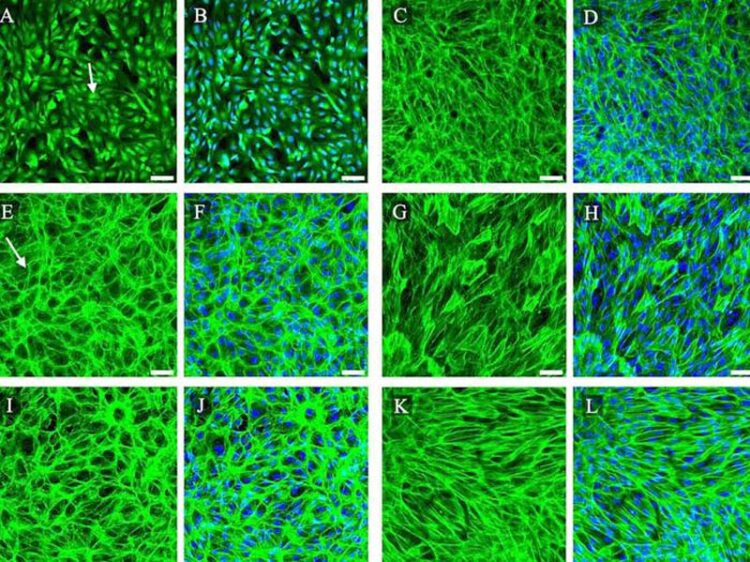From hagfish to membrane: Modeling age-related macular degeneration

Bruch’s membrane is being modeled on a Transwell, which is made of plastic (row 1) compared to hagfish slime proteins (row 2) which are smooth and nonporous. Hagfish slime proteins are the better option for in vitro models.
Credit: American Chemical Society
Researchers at Utah State University have successfully demonstrated that hagfish slime proteins can accurately replicate membranes in the human eye.
Professor Elizabeth Vargis and her team study a condition called age-related macular degeneration that causes damage to the retina, making it difficult to see. They study in vitro models, or a model developed in a laboratory setting, of Bruch’s membrane, a layer in the retina of the eye, to compare the natural aging process to the effects of AMD. They published their research in ACS Biomaterials Science & Engineering this past July.
“By using these models, scientists can better understand the role of Bruch’s membrane in the development of age-related eye diseases,” Vargis said. “This research provides an affordable and widely available option.”
Collaboration with USU Professor Justin Jones determined that hagfish slime proteins are the best choice for replicating Bruch’s membrane while still maintaining desirable properties. Credit: Matt Jensen/Utah State University
Studying the connection between an aging Bruch’s membrane and deterioration caused by AMD is challenging in live subjects due to the slow progression of the disease and the complexity of isolating specific layers of the retina. Creating an in vitro model of Bruch’s membrane that mimics both its healthy and aged states help researchers understand the relationship between physical changes via aging and AMD. The ideal model should be smooth, nonporous and capable of supporting cell growth. It should also replicate the changes that occur with age in thickness, stiffness and permeability.
Previous models of Bruch’s membrane have captured some of its properties but not all. The most common model is a plastic membrane called a Transwell, which supports cell culture in the retina but is much thicker and stiffer than the natural membrane and cannot easily replicate changes from aging. Other models partially represent Bruch’s membrane but are difficult to produce and/or lack certain crucial aspects required to study AMD.
In previous work with USU Biology Professor Justin Jones, researchers manipulated spider silk proteins to replicate Bruch’s membrane, but challenges in isolating proteins and limited adjustability led to the exploration of other materials. Collaboration with Jones determined that hagfish slime proteins are the best choice for replicating Bruch’s membrane while still maintaining desirable properties. Vargis and her team were able to properly grow retinal cells on hagfish slime proteins and prove that the protein’s behavior changes as the membrane mimic stages of aging and disease.
This study was supported by grants from the NIH, BrightFocus Foundation, and the Office of Naval Research.
Journal: ACS Biomaterials Science & Engineering
DOI: 10.1021/acsbiomaterials.3c00411
Method of Research: Experimental study
Subject of Research: Cells
Article Title: Engineering a Biomimetic In Vitro Model of Bruch’s Membrane Using Hagfish Slime Intermediate Filament Proteins
Article Publication Date: 17-Jul-2023
All latest news from the category: Life Sciences and Chemistry
Articles and reports from the Life Sciences and chemistry area deal with applied and basic research into modern biology, chemistry and human medicine.
Valuable information can be found on a range of life sciences fields including bacteriology, biochemistry, bionics, bioinformatics, biophysics, biotechnology, genetics, geobotany, human biology, marine biology, microbiology, molecular biology, cellular biology, zoology, bioinorganic chemistry, microchemistry and environmental chemistry.
Newest articles

Compact LCOS Microdisplay with Fast CMOS Backplane
…for High-Speed Light Modulation. Researchers from the Fraunhofer Institute for Photonic Microsystems IPMS, in collaboration with HOLOEYE Photonics AG, have developed a compact LCOS microdisplay with high refresh rates that…

New perspectives for material detection
CRC MARIE enters third funding period: A major success for terahertz research: Scientists at the University of Duisburg-Essen and the Ruhr University Bochum have been researching mobile material detection since…

CD Laboratory at TU Graz Researches New Semiconductor Materials
Using energy- and resource-saving methods, a research team at the Institute of Inorganic Chemistry at TU Graz aims to produce high-quality doped silicon layers for the electronics and solar industries….



